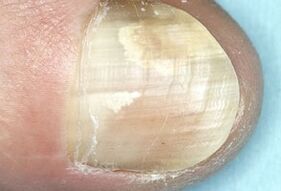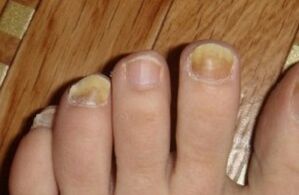
Fungus of the nail plates on the toes (onychomycosis of the feet) is an infectious disease manifested by nail lesions caused by dermatophytes, molds or yeasts.According to statistics, the rate of this disease in the population is up to 10%.
The risk of developing onychomycosis of the feet directly depends on the social and climatic conditions of a person's residence, gender, age, occupation and the presence or absence of other diseases.
One way or another, due to its high contagiousness and ability to significantly impair the patient's quality of daily life, this pathology requires timely detection and comprehensive, competent treatment.
Symptoms of toenail fungus
Depending on the symptomatic manifestations, there are three types of onychomycosis on the feet:
- hypertrophy;
- Normal;
- atrophy.
Hypertrophic lesions of the nails are characterized by a pronounced thickening and deformation of the nail plates, loss of shine and the appearance of a kind of "erosion" at their edges.The clinical picture of the disease can be supplemented by the appearance of pain and the development of onychomycosis (a pathology in which the nail has an appearance similar to a bird's claw).
With onychomycosis of the normal type, yellow or white stripes and spots appear on the nail plates.At the same time, the nails retain their shape, shine and thickness.With atrophic onychomycosis, the nail plate quickly separates from the nail bed, becomes dull and turns gray-brown.The exposed skin will be covered with loose layers of hyperkeratosis.
Clinical signs of toenail fungus are the basis for another classification of onychomycosis, mainly used by foreign doctors.Based on this type, four forms of the disease can be distinguished:
- distal (damage to the free edge of the nail);
- proximal (posterior nail fold lesion);
- lateral (damage to the nail from both sides);
- total (damage to the entire nail plate).
The severity of the manifestations of onychomycosis must be taken into account when planning a treatment program.
Treatment of toenail fungus

The diagnosis of onychomycosis of the feet is made based on the results of visual medical examination, PCR testing, microscopic and cultural studies.Carrying out the above tests allows us to draw conclusions not only about the presence of a fungal infection, but also about the type of pathogen.
Now a few words about how to cure toenail fungus in the shortest possible time.The treatment program for onychomycosis involves the use of topical and systemic medications.The most effective means for treating local fungus on toenail plates are:
- keratolytic antifungal ointments, gels and creams;
- Specialized plaster for mechanical removal of affected nails;
- Antifungal varnishes based on ciclopirox, amorolfine or a mixture of salicylic, benzoic, lactic acid and resorcinol.
Nowadays, systematic therapy of onychomycosis seems to be the most suitable.In recent years, a number of general antifungal drugs have been developed that can increase the effectiveness of treating onychomycosis by up to 90%.
Medicine to treat toenail fungus
Varnish is considered the most effective antifungal varnish.The main outstanding feature of the product is its ability to destroy pathogens in the deep layers of the nail and penetrate into the nail bed.Antifungal creams and ointments include products containing terbinafine.The listed products are applied daily to the affected nail plates and gently rubbed until completely absorbed.The duration of treatment of nail fungus with ointments and creams can vary from 2-6 weeks.The procedure for using topical antifungals must be approved in advance by a dermatologist.
The choice of systematic drugs is carried out taking into account the severity of the disease and the presence or absence of contraindications to their use in the patient.
Prevent toenail fungus
The main measures aimed at preventing the development of onychomycosis on the feet are:
- avoid mechanical trauma to the nail plates;
- refuse to wear rough, tight and ill-fitting shoes;
- Handle pedicure tools carefully;
- Use personal shoes when visiting baths, saunas and swimming pools;
- Monitor the health status of animals, promptly treat identified diseases;
- Does not include the use of other people's personal hygiene items, clothes, towels, or shoes;
- detect and treat diseases promptly;
- Carry out activities aimed at strengthening the body's immune forces.
It is important to understand that self-treatment of nail fungus often not only does not achieve the expected results, but also significantly complicates the course of the disease.Therefore, before using any medicine or folk treatment for fungus, you should coordinate a treatment program with an experienced dermatologist.

























